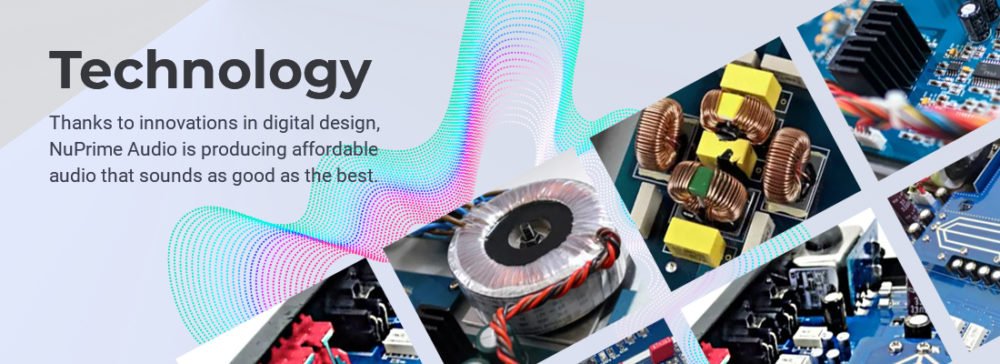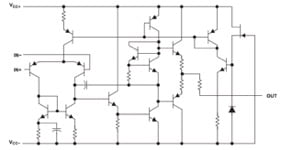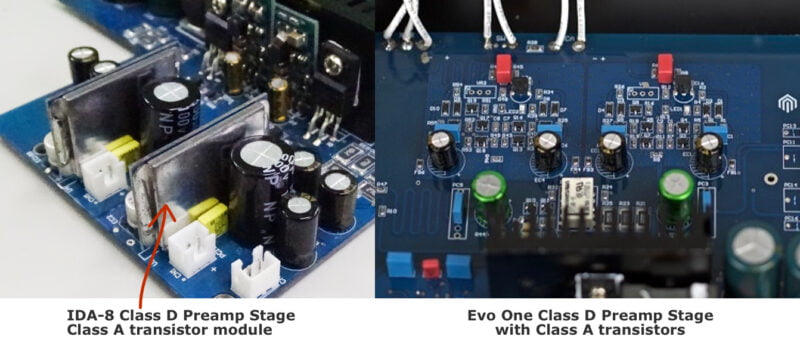
Amp Design & NuPrime’s Advantages
Hybrid Class-D Amplifier Design With Different Sonic Characteristics
At NuPrime, we’ve made a huge leap forward in building world-class amps with different characteristics. Going from achieving one near-perfect design to another, but with different sonic characteristics is a daunting challenge. Very often, when one enhances one sonic aspect he loses another. If we’re aiming at a product that sounds like a tube amp, we don’t want to sacrifice dynamics and speed, and therein lies a stellar achievement. To help readers understand how we get here, we will like to take you back in history where it all begins.
Early Class-D Development
In 2005 The Absolute Sound (USA) honored the NuForce Reference 9 amplifier with its coveted Product of The Year award. In the article accompanying the award Chris Martens stated that Class-D had arrived. At the time Class D’s reputation was less than stellar despite NuForce’s undeniable success. The ten years since have seen numerous refinements of the upstart technology. Of those companies engaging in high-end Class D design, most purchase their modules from ICEpower or Hypex Electronics, tweaking them from there. And of course these modules have improved over time. Every advancement of UcD (now Ncore) or ICE was greeted by critical raves. Likewise, NuForce forged ahead with Versions 1, 2 and 3 of its physically small yet remarkably potent power amps. [See About Us for NuPrime’s history]
Digital versus Analog Class-D Implementation
In simple English, here’s what Class D amplification is about: an input analog signal is modulated into a series of pulses (think of FM or AM signals). Unlike FM and AM, class-D uses the pulse’s width to represent the amplitude of the sampled analog signal. The result is a series of pulses of the same amplitude but of different widths. The pulses are further manipulated into pulses with yet bigger amplitudes. The pulses are then demodulated into the analog signal that drives one’s speaker. Other than converting the initial analog signal into pulses, there is nothing at all digital about this manner of implementation. It is analog in nature. There are many ways of shaping sound with analog techniques. Another kind of Class D implementation is entirely digital: the input signal is converted into ones and zeros via DSP, e.g., Devialet and similar low-power class-D chips. The advantage here is that one can process the sound to enhance the low end, adjust EQ, and so on. This is the point in the journey where Class D is confused with all-digital amplification. Unhappily, there’s a significant drawback to the all-digital approach – it sounds all digital.
NuPrime Amp is not a Digital Amplifier
Switching Amps, commonly known as Class-D, first appeared some decades ago. From the start, Class-D showed enormous potential along with significant shortcomings: limited usable bandwidth, and a fixed saw-tooth waveform for audio-signal modulation accompanied by jitter that masks low-level signals.
Instead of the conventional saw-tooth configuration, NuPrime’s patented circuit design uses a naturally occurring analog-modulating signal that adds neither noise nor jitter. Rather than reverting to off-the-shelf solutions, NuPrime’s in-house advances have further unlocked the switching amp’s potential without the difficulties pure digital-switching amplifiers simply cannot avoid – in other words, the best of both worlds.
Once upon a time heat and bulk were badges of status. Today, they’re the bane of obsolescent technology. NuPrime amps switch at 750,000Hz – more than 10X the CD sampling rate. At these frequencies, transformers and capacitors work far more efficiently, thus making it possible to reduce their size. Typically, Class-A amps rarely utilize more than 30% of the power they draw; the rest is wasted as heat. High operating temperatures also shorten the useful life of the electrolytic capacitors used in abundance in these designs.
Advancement of Class-D Design
In the early days of Class D’s analog implementation, engineers had not figured out how to improve switching frequencies in order avoid various weaknesses in bass performance, HF extension, jitter and so on. We need to bear in mind that solid state and tube implementations also have their congenital weaknesses. The thing is, engineers have been working at refining these modalities for a very long time. That said, there are stubborn holdouts who believe that Class D is not sufficiently resolved and as a consequence sounds less than ideal. In point of fact, for as long as music has been recorded, ultimate resolution lies largely beyond reach. Ideal sound remains a goal, which we suggest, perhaps immodestly, we’ve homed in on to a remarkable degree.
At present, a handful of engineers specializing in Class-D designs can implement switching frequencies at more than 500kHz (CD is 44.1kHz). In our lab, we have designs running at 1MHz with vanishingly low THD at broad ranges of frequencies and power with commendably low jitter. Without belaboring the reader with mind-numbing details, our engineers can now produce class-D amplification that, as we say, lies close to perfection. We’re not suggesting that most engineers know how to accomplish this. The market is crowded with poor implementations of Class-D technology.
Unlike ICEpower or Hypex, we are not in the business of making high-volume modules at low cost. We have spent a lot of time and effort in making amps with contrasting sonic signatures.
Advantages of NuPrime Amplifier Technology
1. High bandwidth. Truly faithful reproduction of music demands bandwidth, and plenty of it. Inadequate bandwidth withholds important spatial information and tonal complexities. NuPrime amps deliver high bandwidth with a ruler-flat response from 20 to 50,000Hz. Only a very few, very expensive linear amplifiers are capable of achieving that. This bandwidth allows NuPrime to amplify complex music with faithfulness far beyond the capability of conventional amps, with particular regard to a vast soundstage – accurate spatial information delivered in full.
2. An extremely high damping factor. Damping factor is simply a measure of an amplifier’s ability to drive and control a speaker. The higher the number, the better. An excellent tube amplifier might have a damping factor between 10 and 100. A high-quality Class-A amplifier might reach 200. A NuPrime amplifier has a damping factor of about 400. And unlike conventional amps, NuPrime’s damping factor is totally unaffected by changes in audio frequencies. Simply stated, NuPrime delivers lightning-fast dynamics to any speaker.
3. Ultra-low distortion and noise. In conventional amplifiers, fixed specifications for distortion and noise simply do not exist. Manufacturers invariably choose to quote the most flattering numbers, typically measured at 1 watt. In reality, when power demands increase, so does distortion and noise. NuPrime employs patent-pending technologies that cancel distortion at every cycle of operation. NuPrime amps maintain the same low distortion characteristics at every output level and audio frequency.
4. No phase shift. Many amps use output filters that create phase shift. When phase shifts, spatial information becomes inaccurate. Most amps present phase shifts of better than 45 degrees at 20 kHz, heading toward 90 degrees as frequency increases. NuPrime amps cancel these distortions owing to a unique closed-loop design producing zero phase shift across all frequencies. Repeat, zero.
Class D With A Soul
How do we create Class D amps with Class A or tube amp sound characteristic? The answer lies in computer simulation (specifically SPICE circuit simulation) of Cass A and tube devices and modeling them using Class A transistors.

Within the Class D topology, the preamp stage is generally implemented using Op Amp. Only a few high end products use discrete transistors design. Discrete transistors design is costly and challenging to accomplish, but they allow us to craft the sonic characteristic.

NuPrime provides unequalled, fully regulated output without ripple voltage or noise. Absent this electronic smog, music emerges from a pristine background, delicate details and nuances intact. Purity has a sound, and it’s beautiful.
In summary, NuPrime’s sonic character stands well apart from – and indeed above – the soft, cushy sound we often associate with most tubed amplification or the dry, edgy sound we often associate with solid-state and switching technology. Rarely does an amp achieve an ideal balance of richly textured timbres and harmonics, bottom-end authority, startling dynamics, exquisite low-level detail, and a fully revealed, fully dimensional soundstage against a backdrop of mile-deep silence.
